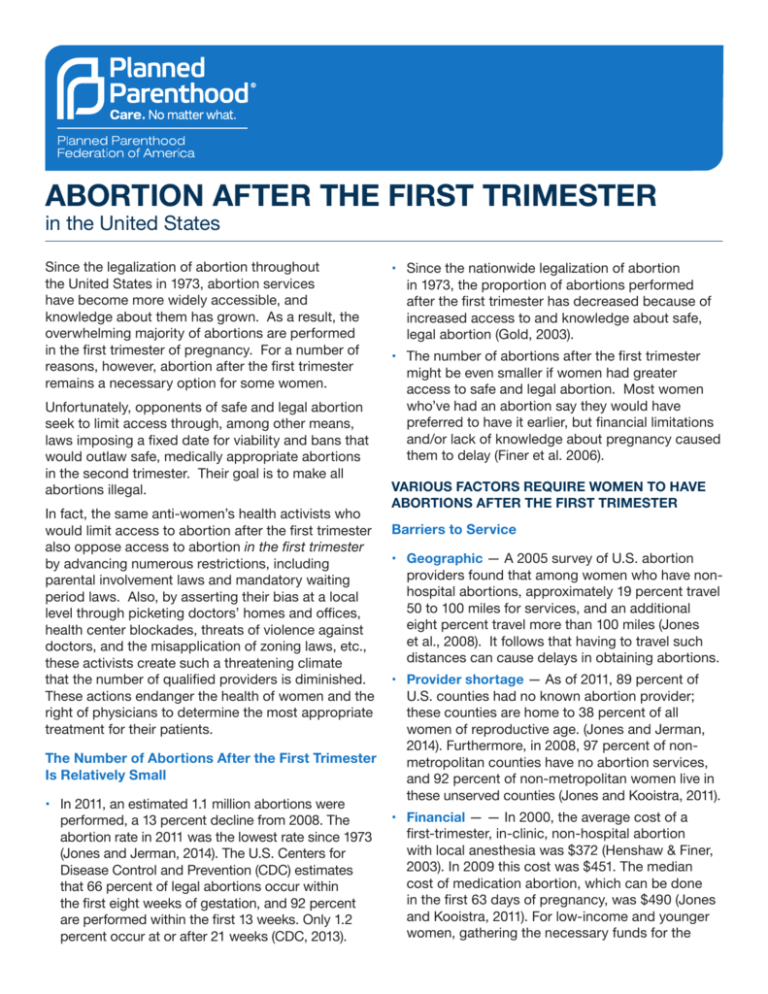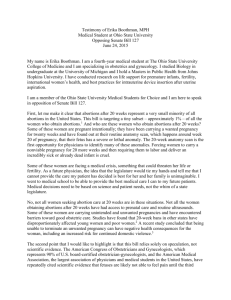
ABORTION AFTER THE FIRST TRIMESTER
in the United States
Since the legalization of abortion throughout
the United States in 1973, abortion services
have become more widely accessible, and
knowledge about them has grown. As a result, the
overwhelming majority of abortions are performed
in the first trimester of pregnancy. For a number of
reasons, however, abortion after the first trimester
remains a necessary option for some women.
Unfortunately, opponents of safe and legal abortion
seek to limit access through, among other means,
laws imposing a fixed date for viability and bans that
would outlaw safe, medically appropriate abortions
in the second trimester. Their goal is to make all
abortions illegal.
In fact, the same anti-women’s health activists who
would limit access to abortion after the first trimester
also oppose access to abortion in the first trimester
by advancing numerous restrictions, including
parental involvement laws and mandatory waiting
period laws. Also, by asserting their bias at a local
level through picketing doctors’ homes and offices,
health center blockades, threats of violence against
doctors, and the misapplication of zoning laws, etc.,
these activists create such a threatening climate
that the number of qualified providers is diminished.
These actions endanger the health of women and the
right of physicians to determine the most appropriate
treatment for their patients.
The Number of Abortions After the First Trimester
Is Relatively Small
• In 2011, an estimated 1.1 million abortions were
performed, a 13 percent decline from 2008. The
abortion rate in 2011 was the lowest rate since 1973
(Jones and Jerman, 2014). The U.S. Centers for
Disease Control and Prevention (CDC) estimates
that 66 percent of legal abortions occur within
the first eight weeks of gestation, and 92 percent
are performed within the first 13 weeks. Only 1.2
percent occur at or after 21 weeks (CDC, 2013).
• Since the nationwide legalization of abortion
in 1973, the proportion of abortions performed
after the first trimester has decreased because of
increased access to and knowledge about safe,
legal abortion (Gold, 2003).
• The number of abortions after the first trimester
might be even smaller if women had greater
access to safe and legal abortion. Most women
who’ve had an abortion say they would have
preferred to have it earlier, but financial limitations
and/or lack of knowledge about pregnancy caused
them to delay (Finer et al. 2006).
VARIOUS FACTORS REQUIRE WOMEN TO HAVE
ABORTIONS AFTER THE FIRST TRIMESTER
Barriers to Service
• Geographic — A 2005 survey of U.S. abortion
providers found that among women who have nonhospital abortions, approximately 19 percent travel
50 to 100 miles for services, and an additional
eight percent travel more than 100 miles (Jones
et al., 2008). It follows that having to travel such
distances can cause delays in obtaining abortions.
• Provider shortage — As of 2011, 89 percent of
U.S. counties had no known abortion provider;
these counties are home to 38 percent of all
women of reproductive age. (Jones and Jerman,
2014). Furthermore, in 2008, 97 percent of nonmetropolitan counties have no abortion services,
and 92 percent of non-metropolitan women live in
these unserved counties (Jones and Kooistra, 2011).
• Financial — — In 2000, the average cost of a
first-trimester, in-clinic, non-hospital abortion
with local anesthesia was $372 (Henshaw & Finer,
2003). In 2009 this cost was $451. The median
cost of medication abortion, which can be done
in the first 63 days of pregnancy, was $490 (Jones
and Kooistra, 2011). For low-income and younger
women, gathering the necessary funds for the
procedure often causes delays. A recent study
found that women at or under 100 percent of the
federal poverty level were more likely than women
at higher income levels to have second-trimester
abortions (Jones and Finer, 2012). Compounding
the problem is the fact that the cost of abortion
rises with gestational age: in 2009, non-hospital
facilities charged an average of $1,500 for abortion
at 20 weeks (Jones and Kooistra, 2011). Most women
are forced to pay for abortions out-of-pocket. In
2008, only 20 percent of abortions were paid
by Medicaid and another 12 percent were billed
directly to private insurance (Jones et al, 2010).
For some women, the cost of abortion can pose
significant barriers to access. Thirty-six percent of
women having abortions in the second trimester
reported that they needed time to raise money
to have the abortion. In addition, 18 percent of
women having abortions in the second trimester
reported that worries about the cost of the
procedure caused them to take more time to make
their decision (Finer, et al., 2006).
• Legal restrictions — Causing additional delays
are state laws that mandate parental consent,
notification, or court-authorized bypass for minors,
and laws that impose required waiting periods.
For example, after Mississippi passed a parental
consent requirement, the ratio of minors to adults
obtaining abortions after 12 weeks increased by 19
percent (Henshaw, 1995).
Medical indications affecting the pregnancy may
also lead to abortion after 12 weeks.
• In a survey of U.S. women deciding to end their
pregnancies, significantly more women in their
second trimester cited fetal health concerns than
women in their first trimester. The fetal health
concerns they cited included the risk of fetal
anomaly due to advanced maternal age, a history
of miscarriage, a lack of prenatal care, and fetal
exposure to prescription medications and non-prescription substances (Finer et al., 2005).
• Conditions in which the woman’s health is
threatened or aggravated by continuing her
pregnancy include:
• certain types of infections;
• heart failure;
• malignant hypertension, including preeclampsia;
• out-of-control diabetes;
• serious renal disease;
• severe depression; and
• suicidal tendencies.
These symptoms may not occur until the second
trimester, or they may become worse as the pregnancy
progresses (Cherry & Merkatz, 1991; Paul et al., 2009).
Other Reasons for Having an Abortion Past 12 Weeks
• Exposure to intimate partner violence.
• Absence of partner due to estrangement or death.
• Lack of financial and/or emotional support from partner.
• Lack of pregnancy symptoms, seeming
continuation of “periods,” irregular menses.
• Psychological denial of pregnancy, as may occur
in cases of rape or incest (Jones and Finer, 2012;
Ingram et al., 2007; Paul et al., 2009).
Adolescents Often Delay Abortion Until After the
First Trimester
• Adolescents are more likely than older women to
obtain abortions later in pregnancy (Jones and
Finer, 2012).
• Among women under age 15, one in five abortions
is performed after 13 weeks’ gestation. Twelve
percent of teens aged 15 to 19 obtained an
abortion after 13 weeks’ gestation (CDC, 2013).
• The very youngest women — those under age 15
— are more likely than others to obtain abortions
at 21 or more weeks’ gestation (CDC, 2013).
• Common reasons why adolescents delay abortion
until after the first trimester include fear of parents’
reaction, denial of pregnancy, and prolonged
fantasies that having a baby will result in a stable
relationship with their partners (Paul et al., 2009).
In addition, adolescents may have irregular periods
(Friedman et al., 1998), making it difficult for them
to detect pregnancy. One study found that teens
took a week longer to suspect pregnancy than
adults did; teens also took more time to confirm
their pregnancies with a pregnancy test (Finer et al,
2006). Also, as previously noted, delays are often
caused by state laws requiring parental consent or
court-authorized bypass for minors.
Abortion After the First Trimester Is as Safe as/or Safer than Carrying a Pregnancy to Term
• Overall, abortion has a low morbidity rate. Less
than 0.3 percent of women undergoing legal
abortion procedures at all gestational ages sustain
a serious complication requiring hospitalization
(Boonstra et al., 2006; Henshaw, 1999). The rate
of complication increases 38 percent for each
additional week of gestation beyond eight weeks
(Paul et al., 2009).
• The risk of death from medication abortion through
63 days’ gestation is about one per 100,000
procedures (Grimes, 2005). The risk of death with
a surgical abortion is about one per one million
through 63 days’ gestation (Bartlett et al., 2004).
The risk of death from miscarriage is about one
per 100,000 (Saraiya et al., 1999). But the risk of
death associated with childbirth is about 14 times
as high as that associated with abortion (Raymond
& Grimes, 2012).
• The risk of death associated with surgical abortion
increases with the length of pregnancy, from one
death for every one million abortions at eight or fewer
weeks to 8.9 deaths for every one million abortions
after 20 weeks’ gestation (Boonstra et al., 2006). In
comparison, the maternal mortality rate in the U.S.
in 2007 was 12.7 deaths per 100,000 live births —
a significant difference in maternal mortality rates
between deciding to end a pregnancy by abortion or
carrying it to term (Paul et al., 2009; Xu et al., 2010).
CURRENT LAW GUARANTEES WOMEN THE
RIGHT TO ABORTION AFTER THE FIRST
TRIMESTER
Legality of Abortion
• In Roe v. Wade (410 U.S. 113 (1973)), the U.S.
Supreme Court held that the U.S. Constitution
protects a woman’s personal decision to end a
pregnancy. Only after viability — being capable
of sustained survival outside the woman’s body
with or without artificial aid — may the states
ban abortion altogether. Abortions necessary to
preserve the woman’s life or health must still be
allowed, however, even after viability.
• Prior to viability, states can regulate abortion, but
only if the regulation does not impose a “substantial
obstacle” in the path of a woman deciding to have
an abortion (Harrison & Gilbert, 1993).
Determination of Viability
In Planned Parenthood of Central Missouri v.
Danforth (428 U.S. 52 (1976)), the U.S. Supreme Court
recognized that judgments of viability are inexact
and may vary with each pregnancy. As a result, it
granted the attending physician the right to ascertain
viability on an individual basis. In addition, the court
rejected as unconstitutional fixed gestational limits
for determining viability. The court reaffirmed these
rulings in the 1979 case Colautti v. Franklin (439 U.S.
379 (1979)).
State Laws and Abortion Facilities
In City of Akron v. Akron Center for Reproductive
Health (462 U.S. 416 (1983)), the U.S. Supreme Court
invalidated a costly requirement that all secondtrimester abortions take place in a hospital.
Laws and Specific Abortion Techniques
• In Thornburgh v. American College of Obstetricians
and Gynecologists (476 U.S. 747 (1986)), the U.S.
Supreme Court ruled that a woman may not be
required to risk her health to save a pregnancy
even after viability, and it granted the attending
physician the right to determine when a pregnancy
threatens a woman’s life or health. The court also
ruled that when performing a post-viability abortion,
a physician must be permitted to use the method
most likely to preserve the woman’s health.
• On April 18, 2007, in Gonzales v. Carhart (550
U.S. 124 (2007, April 18)) and Gonzales v. Planned
Parenthood Federation of America, Inc. (550 U.S.
___ (2007, April 18)), the U.S. Supreme Court
ignored 30 years of precedent that held women’s
health must be the paramount concern in laws that
restrict abortion access, and in a 5–4 decision,
upheld the so-called Partial-Birth Abortion Ban
Act of 2003 (the “federal abortion ban”) — the first
federal legislation to criminalize abortion.
• The federal abortion ban, which does not contain
an exception for the woman’s health, makes it a
federal crime to take certain steps when performing
an abortion after the first trimester. The ruling allows
Congress to ban certain second-trimester abortion
procedures, despite the fact that doctors and major
medical organizations, including the American
College of Obstetricians and Gynecologists, believe
the banned procedures are sometimes the safest
and best to protect women’s health.
• The recent Carhart and Planned Parenthood
Federation of America, Inc. rulings may make
it easier for states, as well as the federal
government, to further limit a woman’s ability
to end a pregnancy, especially after the first
trimester. This shift will likely spur state efforts
to enact new abortion restrictions. Indeed,
opponents of women’s health continue to work
tirelessly to chip away at or limit access for
women. The Guttmacher Institute released a
report showing that 70 provisions were passed in
22 states in 2013 to restrict access to abortion.
More state abortion restrictions were enacted
in 2011–2013 than in the entire previous decade
(Guttmacher Institute, 2014a).
Protecting the Right to Make Personal Medical Decisions — Planned Parenthood
Continues Its Fight
Despite the federal abortion ban taking effect,
Planned Parenthood will continue to provide highquality care, including second-trimester abortion
services, to our clients. Planned Parenthood will also
continue to support vital efforts to protect access
to safe and legal abortion services at the state and
federal levels.
Currently, seven states — California, Connecticut,
Hawaii, Maine, Maryland, Nevada, and Washington
— have passed Freedom of Choice Acts (FOCA), and
other states are seeking to pass similar legislation
(Guttmacher Institute, 2014b). Although state-level
FOCAs have no impact on the federal abortion ban,
such laws prohibit the state government from interfering
with the decision to continue or end a pregnancy.
Cited References
Bartlett, Linda A., et al. (2004). “Risk Factors for Legal Induced Abortion-Related Mortality in the United States.” Obstetrics & Gynecology, 103(4), 729–37.
Boonstra, Heather D., et al. (2006, accessed 2013, March 4). Abortion in Women’s Lives. New York: Guttmacher Institute. [Online]. http://www.guttmacher.org/
pubs/2006/05/04/AiWL.pdf.
CDC — Centers for Disease Control and Prevention. (2013, November 29, accessed 2013, December 3.). “Abortion Surveillance — United States, 2010.”
Morbidity and Mortality Weekly Report, 62(SS-8). [Online]. ].http://www.cdc.gov/mmwr/preview/mmwrhtml/ss6208a1.htm?s_cid=ss6208a1_w.
Cherry, Sheldon & Irwin Merkatz, eds. (1991). Complications of Pregnancy: Medical, Surgical, Gynecologic, Psychosocial, and Perinatal, 4th Edition. Baltimore, MD:
Williams & Wilkins.
City of Akron v. Akron Center for Reproductive Health, 462 U.S. 416 (1983).
Colautti v. Franklin, 439 U.S. 379 (1979).
Finer, Lawrence B., et al. (2005). “Reasons U.S. Women Have Abortions: Quantitative and Qualitative Perspectives.” Perspectives on Sexual and Reproductive Health,
37(3), 110–8.
_____. (2006). “Timing of steps and reasons for delays in obtaining abortions in the United States.” Contraception, 74 (4), 334–44.
Friedman, Stanford B., et al. (1998). Comprehensive Adolescent Health Care, 2nd Edition. St. Louis, MO: Mosby.
Gold, Rachel Benson. (2003, accessed 2013, March 4). “Lessons from Before Roe: Will Past Be Prologue?” The Guttmacher Report on Public Policy, 6(1), 8–11.
[Online]. http://www.guttmacher.org/pubs/tgr/06/1/gr060108.html.
Gonzales v. Carhart, 550 U.S. 124 (2007, April 18, accessed 2013, March 4). [Online]. http://www.supremecourt.gov/opinions/06pdf/05-380.pdf.
Gonzales v. Planned Parenthood Federation of America, Inc., 550 U.S. ___ (2007, April 18, accessed 2013, March 4). [Online]. http://www.supremecourt.gov/
opinions/06pdf/05-380.pdf.
Grimes, D.A. (2005). “Risks of Mifepristone Abortion in Context.” Contraception, 71, 161.
Guttmacher Institute . (2014a, accessed February 3, 2014). Laws Affecting Reproductive Health and Rights: 2013 State Policy Review. [Online]. http://www.
guttmacher.org/statecenter/updates/2013/statetrends42013.html.
_____. (2014b, February, accessed February 3, 2014). State Policies in Brief: Abortion Policy in the Absence of Roe. [Online]. http://www.guttmacher.org/
statecenter/spibs/ spib_APAR.pdf.
Henshaw, Stanley K. (1995). “The Impact of Requirements for Parental Consent On Minors’ Abortions in Mississippi.” Family Planning Perspectives, 27(3), 120–2.
_____. (1999). “Unintended Pregnancy and Abortion: A Public Health Perspective.” Pp. 11–22 in Maureen Paul, et al., eds., A Clinician’s Guide to Medical and
Surgical Abortion. New York: Churchill Livingstone.
Henshaw, Stanley K. & Lawrence B. Finer. (2003). “The Accessibility of Abortion Services in the United States, 2001.” Perspectives on Sexual and Reproductive
Health, 35(1), 16–24.
Ingram, Roger, et al. (2007, April, accessed 2013, March 4). Second-Trimester Abortions in England and Wales. Southampton, UK: Centre for Sexual Health
Research. [Online]. http://www.soton.ac.uk/lateabortionstudy/late_abortion.pdf.
Jones, Rachel K., and Lawrence B. Finer. (2012). “Who has second-trimester abortions in the United States?” Contraception, 85(6), 544-51.
Jones, Rachel K., and Jenna Jerman. (2014). “Abortion Incidence and Service Availability in the United States, 2011.” Perspectives on Sexual and Reproductive Health,
46(1). [Online]. http://www.guttmacher.org/pubs/journals/psrh.46e0414.pdf
Jones, Rachel, et al. (2008). “Abortion Incidence and Services in the United States in 2005.” Perspectives on Sexual and Reproductive Health, 40(1), 6–16.
_____. (2010, accessed 2013, March 4). Characteristics of U.S. Abortion Patients, 2008. New York: Guttmacher Institute. [Online]. http://www.guttmacher.org/
pubs/US-Abortion-Patients.pdf.
Partial-Birth Abortion Ban Act of 2003, S. 3, 108th Cong., 1st Sess. (2003, accessed 2013, March 4). [Online]. http://news.findlaw.com/hdocs/docs/
abortion/2003s3.html.
Paul, Maureen, et al. (2009). Management of Unintended and Abnormal Pregnancy: Comprehensive Abortion Care. Chichester, West Sussex: Wiley-Blackwell.
Planned Parenthood of Central Missouri v. Danforth, 428 U.S. 52 (1976, accessed 2013, March 4). [Online]. http://www.law.cornell.edu/supct/html/historics/USSC_
CR_0428_0052_ZS.html.
Raymond, Elizabeth G., and David A. Grimes. (2012). “The Comparative Safety of Legal Induced Abortion and Childbirth in the United States.” Obstetrics and
Gynecology, 119(2 Part 1), 215-9.
Roe v. Wade, 410 U.S. 113 (1973, accessed 2013, March 4). [Online]. http://www.law.cornell.edu/supct/html/historics/USSC_CR_0410_0113_ZS.html.
Saraiya, M., et al. (1999). “Spontaneous Abortion-Related Deaths Among Women in the United States, 1981-1991.” Obstetrics and Gynecology, 94(2), 172–6.
Thornburgh v. American College of Obstetricians and Gynecologists, 476 U.S. 747 (1986, accessed 2013, March 4). http://www.law.cornell.edu/supct/html/historics/
USSC_CR_0476_0747_ZS.html.
Xu, Jiaquan, et al. (2010, May 20, accessed 2013, March 6). “Deaths: Final Data for 2007.” National Vital Statistics Reports, 58(19). Hyattsville, MD: National
Center for Health Statistics. [Online]. http://www.cdc.gov/nchs/data/nvsr/nvsr58/nvsr58_19.pdf.
© 2014 Planned Parenthood Federation of America, Inc. All rights reserved. Planned Parenthood®, PPFA®, and the logo of “nested Ps” are registered service marks of PPFA.
Media Contact — 212-261-4433
Last updated February 2014






